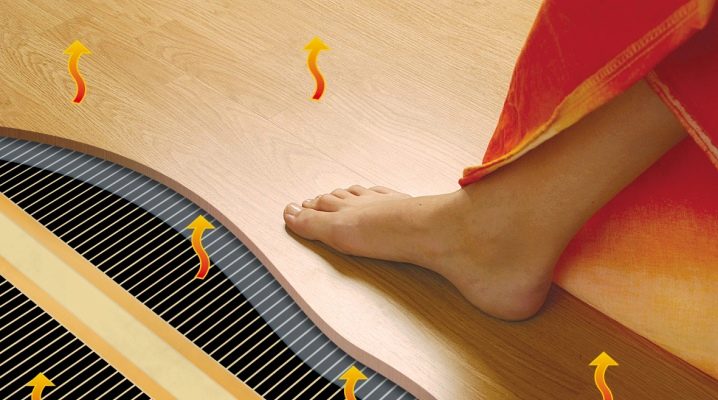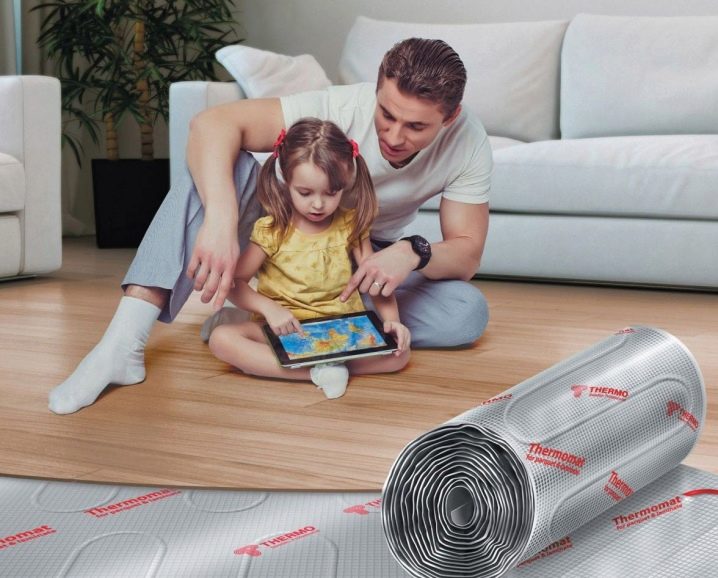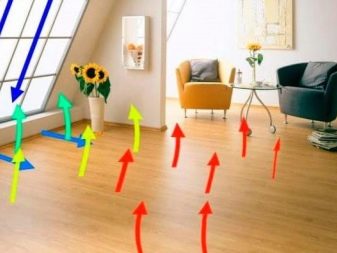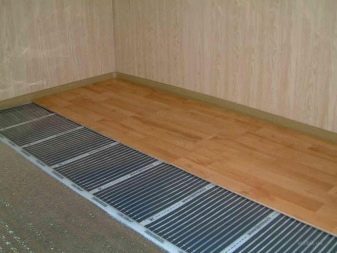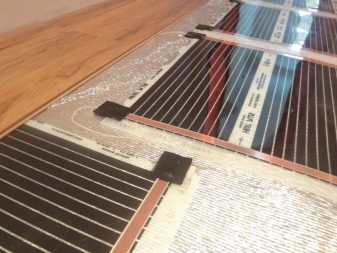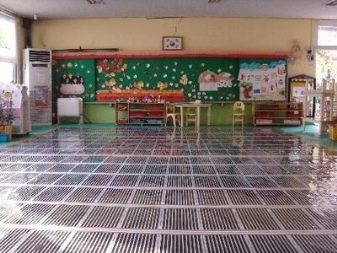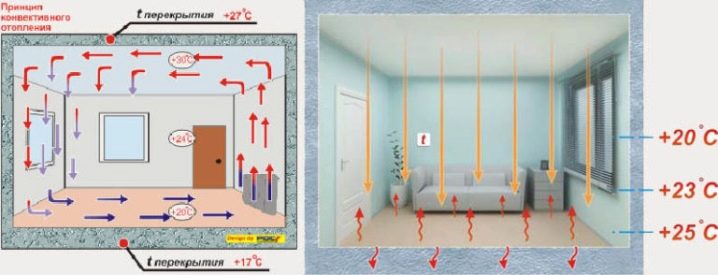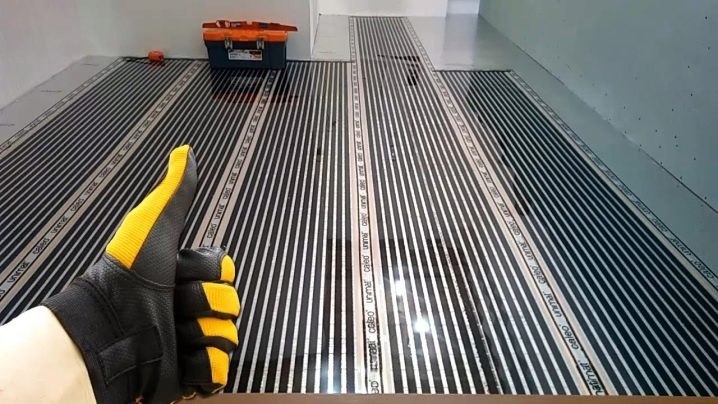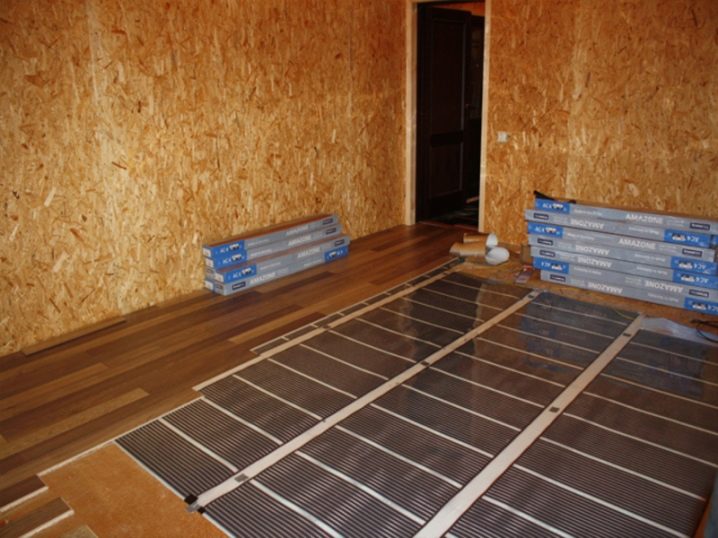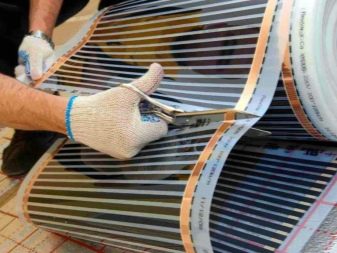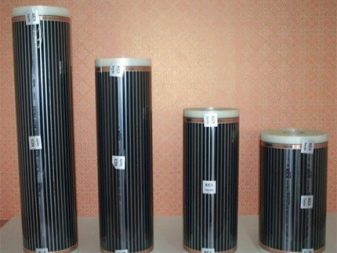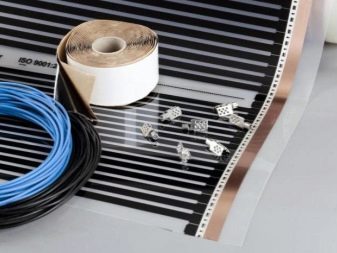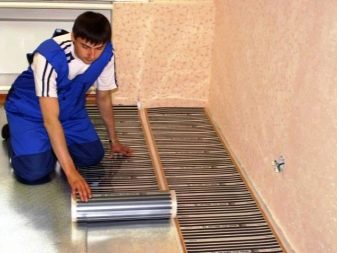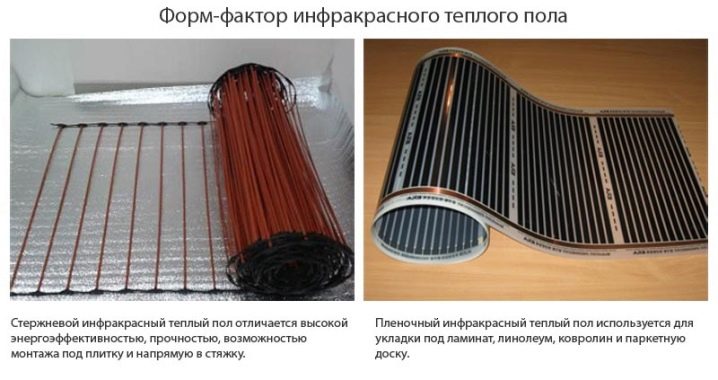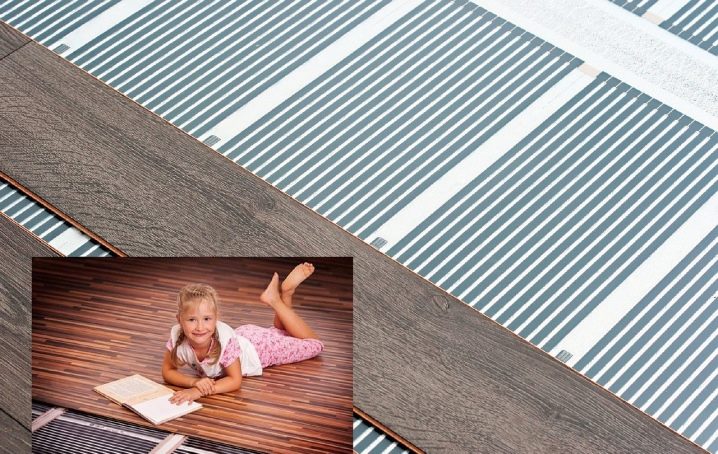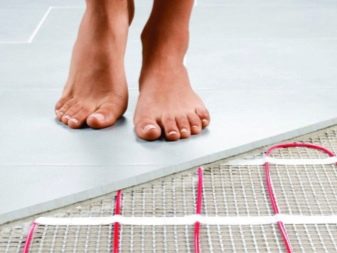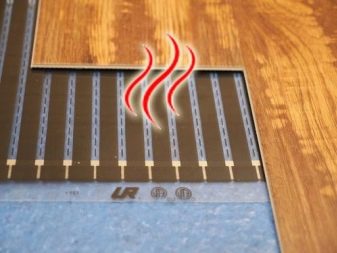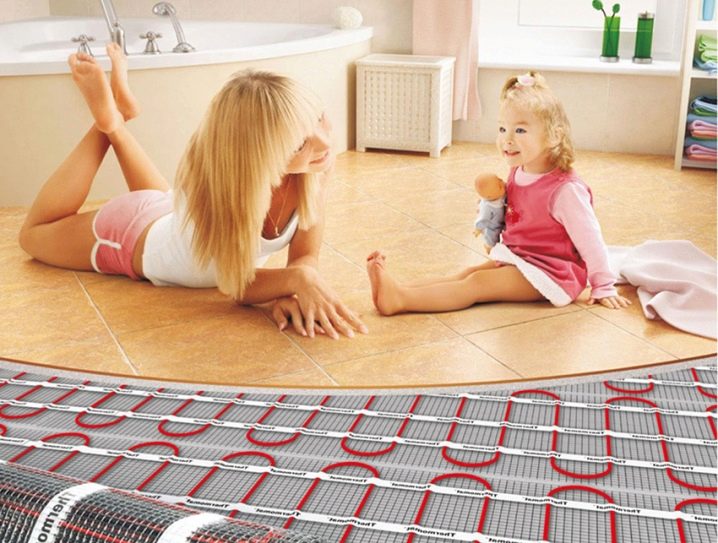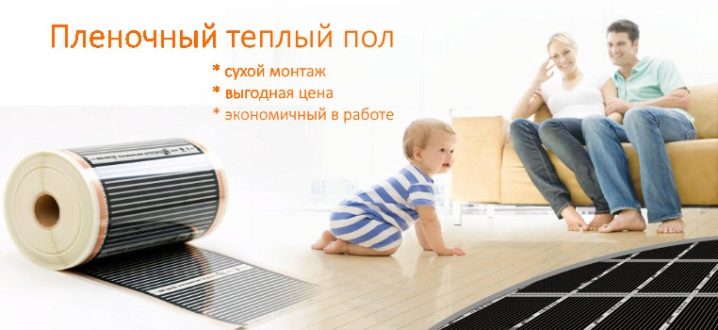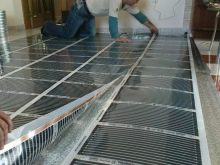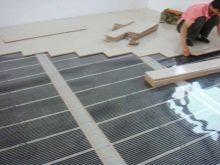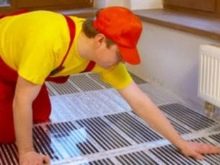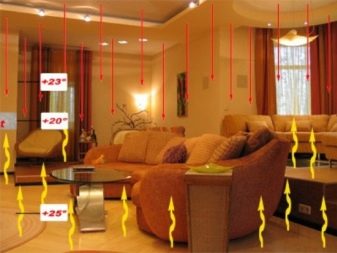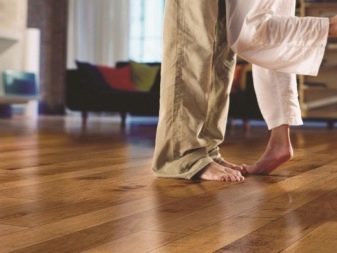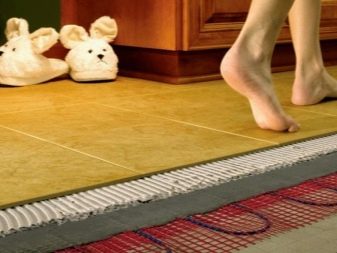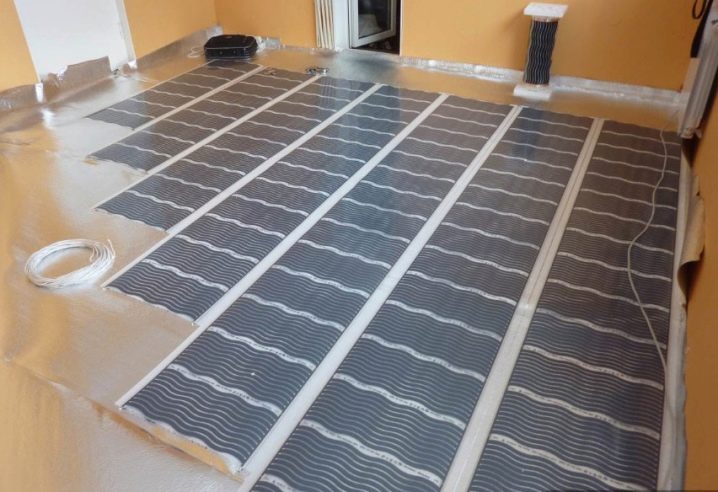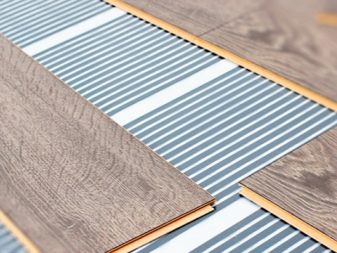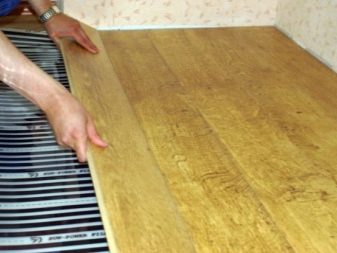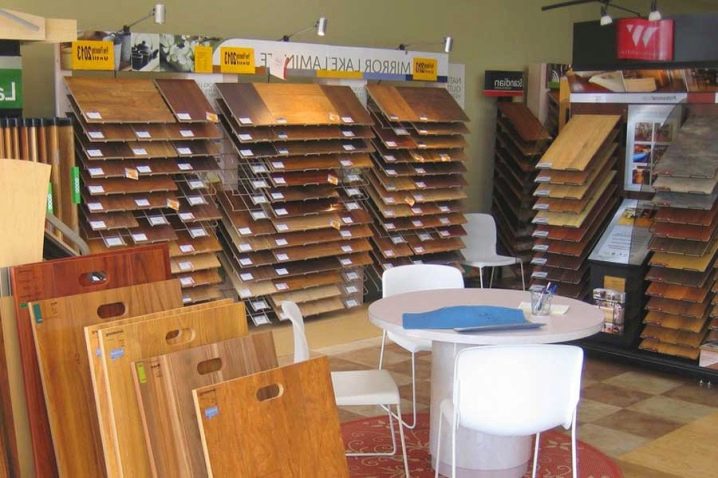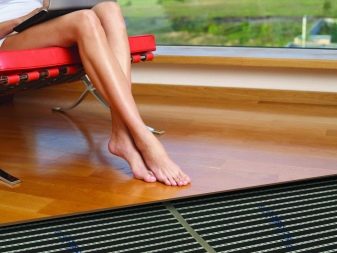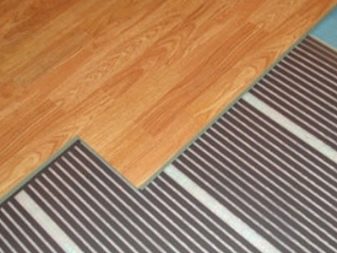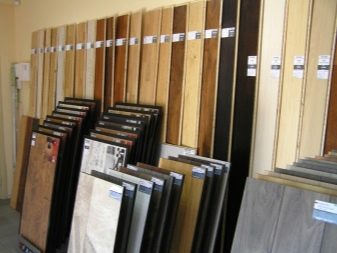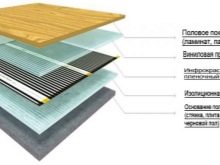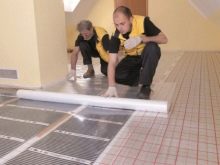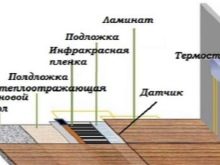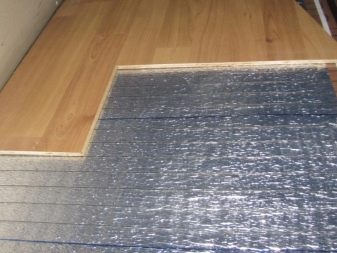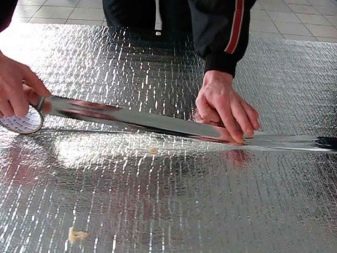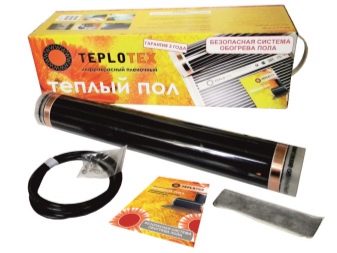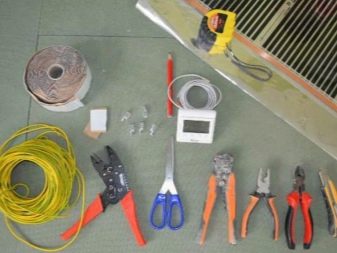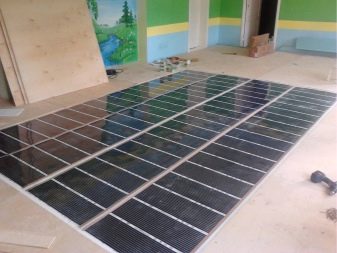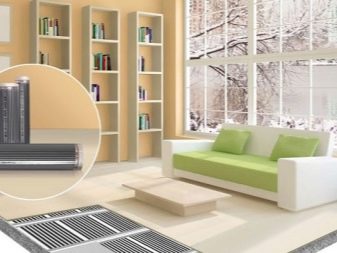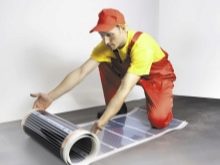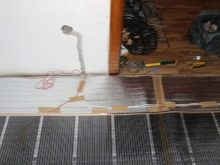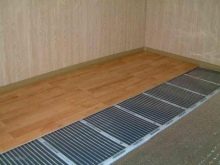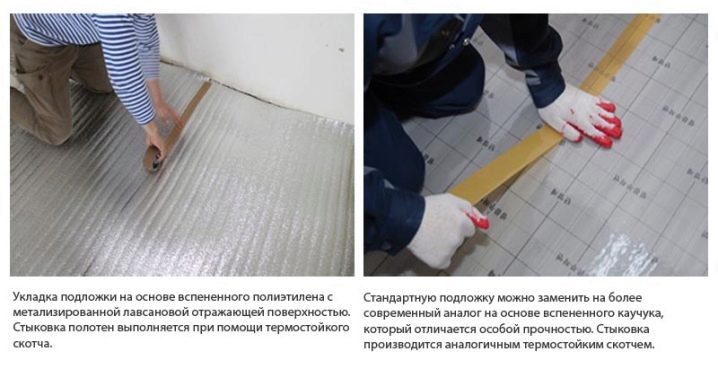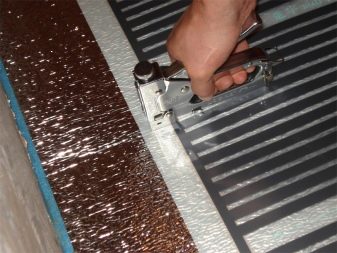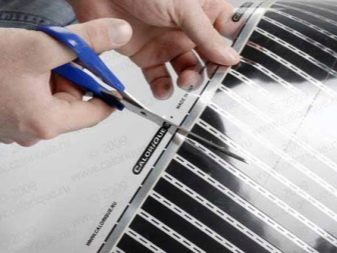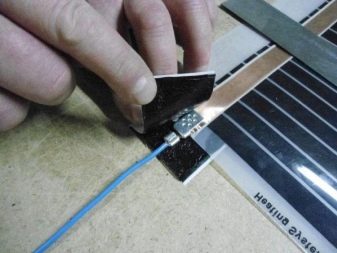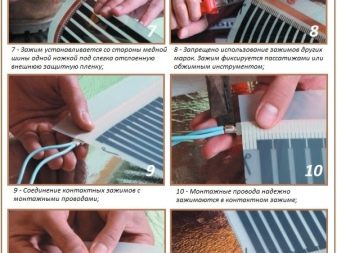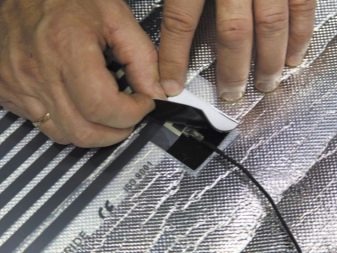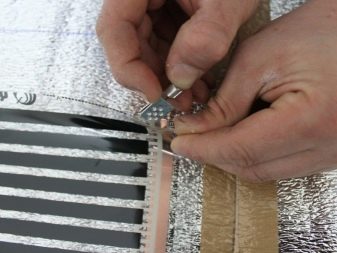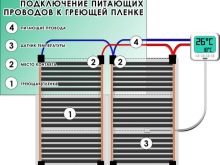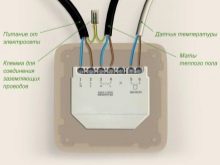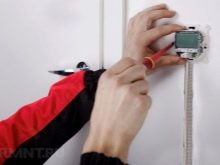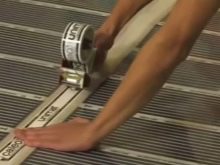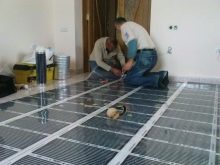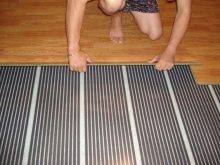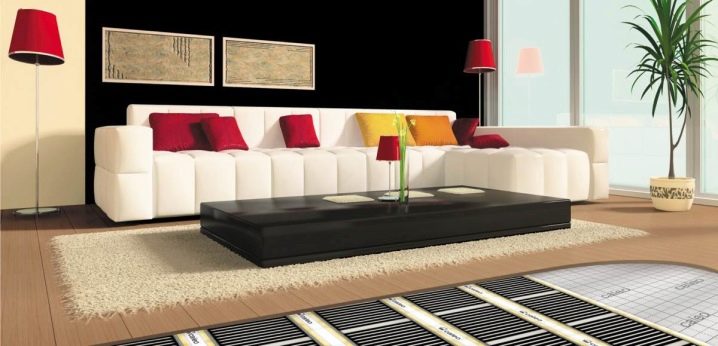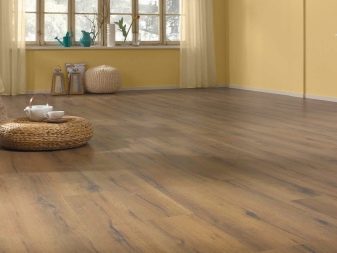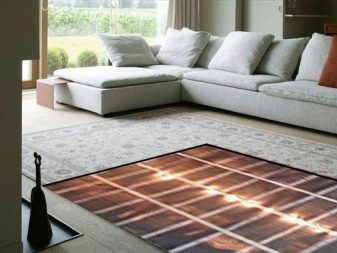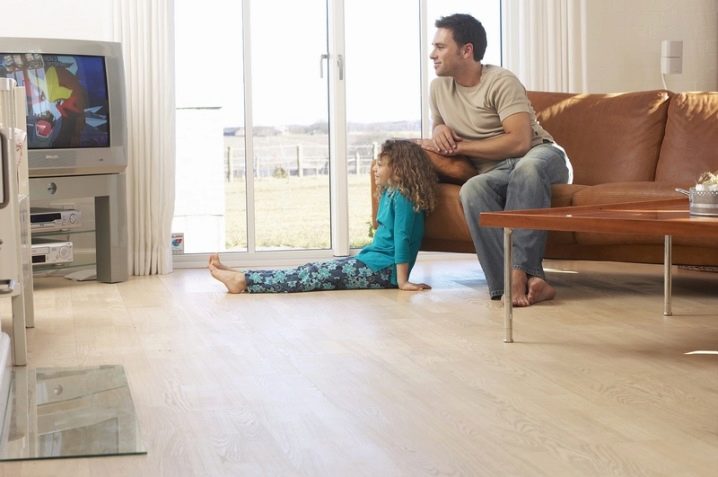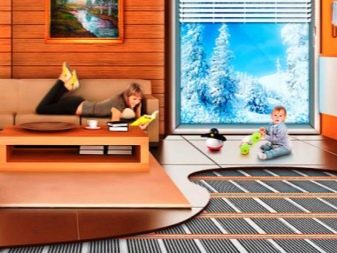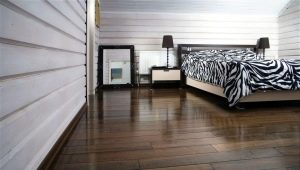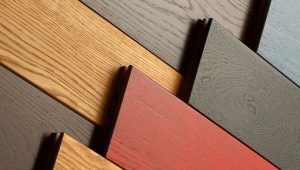How to choose an infrared heated floor under the laminate and install?
Nowadays, many choose laminate as a floor covering, since it is rather beautiful, durable and easy to install. But this coating has several drawbacks, one of which is that it is very cold. That is why an excellent solution to this problem is to install an infrared heated floor under the laminate.
What is infrared floor?
Infrared warm floor, in fact, is a method of heating the surface, which is carried out by increasing the temperature of the heating elements with electricity. The infrared heater has special conductive strips that allow the passage of electricity and heat the surface. Electricity flows through the wiring and heats the floor evenly. It is this system causes full tightness of the infrared floor and its resistance to high humidity.
This design has a thermostat. With it, you can independently change the temperature in the room and in its individual zones. Infrared warm floor is completely harmless to human health. It emits only negatively charged ions, thereby even having a positive effect.
Another feature of this floor is that it warms the entire room. This is due to the fact that a heat-reflecting lining is installed under it, which gradually heats the objects on top. In this way, this device will heat the floor, not the ceiling of the neighbors in case it is installed in the apartment. Infrared floor does not warm the air, so warming up is gradual and correct.
This design is perfect as a base for laying laminate precisely because it provides a uniform heating of the surface, which is gentle to this coating. In addition, such a system of warm floors is economical, allowing you to reduce the cost of electricity for such heating by 20%.
Laminate flooring is an excellent coating for underfloor heating, since it is rather thin and uniform.Thus, the heat is properly distributed over the entire area of the room. Heated floor does not focus the radiation inside the laminate, and passes it through. Warm floor under the laminate allows you to maintain a comfortable temperature in the room and makes moving around the house barefoot more enjoyable. This heating system provides owners the ability to independently control a comfortable temperature in any room. In addition, the laminate is perfectly suited to such a heat source, so that the infrared floor heating system is indispensable in modern conditions.
Basically, these floors are powered by film heaters. They are transparent polyester sheets, between which there are parallel strips of carboxylic paste. When exposed to voltage, it emits infrared energy. The average width of such films is either 50 cm or 100 cm. The length may depend on the size of the room, the film can be easily cut along the cutting line. In other parts, trim coating is prohibited.
Under the laminate flooring is most often used, the heating power of which is 150 W per square meter.Thus, the heating will not exceed 40 degrees, this level will be valid for the laminate. The infrared heat-insulated floor has a special sensor with a cable connected to it, which allows you to control the temperature.
Types, their advantages and disadvantages
Now manufacturers are the two main systems of infrared floors. There are:
- film;
- pivotal.
The first option is a model of thin film rolls having heating elements in the form of strips. The second option is a set of carbon rods that are connected to each other using wires. The first type is very popular because it has a number of advantages, it is easy to install. It does not have to carry out any additional or preparatory work. Everyone can cope with this task, even without having relevant skills or experience in this field. Such a heating system can be installed on any floor, regardless of its texture, and you can not use the coupler.
Another important advantage of the infrared floor is that It allows you to adjust the temperature in the roomcreating a feeling of comfort. In addition, temperature fluctuations can occur quite quickly.
If you suddenly decide to turn on and warm the floor, then it will warm up in a matter of minutes, and the temperature in the room will noticeably increase. This is a clear advantage of infrared warm floors in comparison with other coatings.
An important advantage of this type of underfloor heating is that it does not harm the finish flooring. That is why this type of heating system is most often used in combination with laminate. A big plus is the very principle of the heating system. It does not warm the air and does not allow it to rise up. The system evenly distributes warm flows, and thus, the air temperature below will be significantly higher than at the top.
Infrared radiation is a completely safe and even beneficial phenomenon. It does not affect the level of humidity in the air, does not overdry it, and makes staying indoors more comfortable. In addition, many experts indicate that infrared floors have a therapeutic effect and can carry out the prevention of a number of diseases.Thus, they do not harm at all, but, on the contrary, contribute to the improvement of conditions in the room.
The film infrared floor will allow to warm up the room optimum. This is one of the most economical ways to heat. Such a heater significantly reduces energy consumption. In addition, it allows you to provide a comfortable level of heating for the legs. Even if any part of the system fails, you will not have to change the entire system completely. You can only replace a certain area and enjoy the warm floor.
Manufacturers guarantee a long life of such heaters, even if they run smoothly. These heating systems do not require special care, they are distinguished by their versatility, simplicity and functionality. That is why they are so widespread and very popular among buyers. But such a heating system has several drawbacks. The first of these is the high cost of the heating system.
Not everybody can afford such a warm floor, especially if you buy only high-quality, proven heating models. Besides, with improper installation or some mechanical effects such floors can easily damageb and partially disable the system, and some heating elements will have to be replaced.
Also, many manufacturers caution: there is a possibility of ignition of film underfloor heating. That is why it is very important to take into account the requirements for operation, which impose manufacturers, and carefully study the entire manual. Another disadvantage is that not everyone can properly connect the necessary contacts, especially for models of the second type.
For some, especially very thin models, a flat surface is also required for laying the floor, so you have to additionally align it and smooth out all defects. Another disadvantage is that energy saving can be achieved only if the floor warms up the room at least up to 21 degrees. In addition, this additional heating can not replace the main one.
Some have identified other infrared floor imperfections. So, customers complain that installing and installing it is not as easy as manufacturers say.It is quite easy to calculate the size of the film and correctly spread it across the floor, but connecting all the contacts is a very laborious and complicated process that only an electrician can handle.
Another disadvantage is the clear requirement for a perfectly flat and smooth surface. This is because In some cases, the film is very thin, so there is the possibility of contact separation or damage.
If the film is deformed, the heating system will fail.
Also, many manufacturers claim that infrared floors do not dry the air. This statement is true only if they are used separately from the general heating system, but together both systems dry the air and lower the humidity level in the room. Although manufacturers often mention such an advantage as air ionization and health benefits, yet this radiation can lead to allergic reactions. Thus, the system is not hypoallergenic and may cause some problems.
When installing it is important to pay attention to the air temperature and floor temperature sensors: they should not be closed.Failure to comply with this requirement can lead to unpleasant consequences - the system will fail and will work incorrectly.
How to choose?
When choosing warm infrared floors under the laminate, make sure that the floor surface is perfectly flat, otherwise the system will not work. Preference should be given to the film infrared floor. This is due to the fact that the core system creates certain difficulties during installation and requires a tie. It is not well suited for laminate, but is acceptable.
Before choosing, you must produceand all the measurements in the room and calculate how many rolls of film you need to buy. Infrared electric floor can be installed in any room, including on the balcony, the choice will depend only on the available area.
It is important not only to choose the floor system itself, since in some cases it is identical, but also a laminate for film-type floor heating. You can buy a steady vinyl laminate. It is important to pay attention to the labeling.
On the package should be indicated that such a coating is suitable for installation on heated floors. A bundle of laminate coating should be marked,some manufacturers even indicate the permissible heating temperature (the limit figure is 27 degrees). It is also important to consider the density of the laminate and its structure. It is better to give preference to models that have a looser structure, since they conduct heat better and heat the room well. A denser laminate, on the contrary, warms up for a very long time and practically does not give off heat.
When choosing it is important to pay attention to the composition of the slats. So, if they are made using formaldehyde, which is typical for models of MDF, which are the basis of the laminate, then when heated, this component can release harmful substances. If such a laminate is heated to no more than 25 degrees, the level of discharge is normal, but at higher temperatures their level rises. That is why it is better to give preference to E1 class laminate. It can be heated to 27 degrees, without fear that harmful substances will be released.
Also note the price of coverage. Many people strive to save on this material by purchasing cheaper lamellae, but in the case of a warm floor, this is wrong.
Cheap low-quality slats quickly deteriorate, and therefore have to re-cover. Thus, saving on it, you will later spend even more.
Pay more attention to the substrate. Her choice is extremely important when installing a heated floor. It can equalize the pressure on the locks connecting the slats, and reduce the load on them when walking. The substrate must be laid on the film underfloor heating. It also allows heating uniformity. The film should also be chosen very responsibly and carefully. Only a specific substrate can be placed on the film floor. So, technical cork, extruded polystyrene foam, materials with reflective surfaces, liquid composite systems are perfect for this.
In no case do you get a foil backing, since it is unacceptable for laminate and underfloor heating. It increases the heat, increasing the permissible temperature level.
How to set your own hands?
When installing the infrared floor with your own hands, you need to acquire some tools and follow a number of requirements. So, will be needed:
- substrate with heat reflecting functions;
- infrared film;
- temperature sensors;
- temperature regulators;
- wiring;
- fasteners - clamps for installing infrared paintings;
- insulators;
- plastic film that protects against moisture;
- insulating tape;
- knife, scissors;
- ruler;
- roulette;
- pencil.
In order to properly put the laminate and make a warm floor, it is important to comply with the technology and check all components.
This heating system should be removed from other sources of heat, such as a battery, stove, fireplace and others. It is better if the distance will be about half a meter. The installation should also take into account the location of the furniture in the room. It is better if the warm film is located only in those areas where there will not be furniture, it is important to calculate in advance.
When installing, it is necessary to provide the ability to control the functioning of the heated floor, additional access to the system to troubleshoot when they occur. It is very important when laying laminate. It should provide the necessary ventilation for a warm floor and a level of thermal conductivity. Also need to take care about a perfectly smooth foundation of the floor and get rid of all the bumps and cracks. In addition, you need to install sockets to connect a heated floor to the power supply.
After that, you can carry out the preparation and isolation. Initially, the floor should be cleaned and all dirt and debris removed, even small debris can damage the film surface. For this it is better to use a vacuum cleaner. After that it is necessary to take measurements: floor area except for the floor areas where the furniture will be located. Be sure to correctly calculate the material.
In no case can the infrared film floor be laid on a pad. It is better to leave a small distance with a lack of length or width of such floors than to apply one film on another. After that, you need to build a special substrate that reflects heat. The substrate spreads over the entire floor area. It is much easier to shorten or trim.
Then it is necessary to glue on the outside all the joints of this protective substrate, properly cut the infrared film, based on the measurements made. Moreover, it can be cut only in specially designated areas by the manufacturer. As a rule, they are marked with white frames.The film can be laid on the floor in the room around the perimeter in case there is no large furniture standing directly on the floor.
If there is one, then it is better to bypass it. Then you need to conduct insulation tires. Copper tires need to be glued with electrical adhesive tape, while twisting along the cut. Try to make a complete isolation without the possibility of air intake. After that it is necessary to process the grounding tire. This is the element that is located in the center of each heating sheet.
It is necessary to bend on both sides without deforming the remaining cuts. To isolate the film in other areas, you must use electrical adhesive tape. It must be applied in such a way that the bend is on the wrong side. After that, you can isolate the film with scotch tape. It is glued in half the width and bent over the cut of the infrared canvas. After insulating and stacking, you can proceed to connecting the thermostats and soldering all the wires.
So, it is better to align the film in the place of laying and fix the edge of the substrate with the side that will be opposite to the temperature regulator.Then it is necessary to solder the wires connecting different parts of the film infrared floor. Having bent a film in that part where the temperature regulator is installed, it needs to be folded inside out. You can temporarily secure it in this position with adhesive tape.
Then, using a heated soldering iron or a clerical knife, you need to get rid of the insulation layer. You can also mark points to melt the insulation, and then clean the sections with a knife. Thereafter it is important to completely isolate. This can be done with electrical adhesive tape.
After that, proceed to the installation of the sensor temperature of the floor. This device must be installed under the film in a special recess. Thermal sensors are installed in the warmest place of the infrared floor, which is the central part of the film. In this way, overheating of the entire floor can be avoided. Thermal sensor has a wire to the thermostat. There it needs to be fixed with a special tape. Then you should strip the wires and connect them. After that, you need to make a connection to the grounding tires, and it is important to make them stripped, cut and connect with a cable.
Outgoing wires should be placed in a corrugated pipe.
Then you need to fix the film. You can do this by fixing it on a substrate with the help of mounting tape. So you can make a flat surface and avoid overlapping different sections of each other. Then you can proceed to the testing of film infrared floor heating and laying laminate. From above on floors polyethylene film keeps within. It allows you to protect the infrared floor from moisture.
Laying the film should be overlapped on the walls, and the thickness of the polyethylene film should be at least 160 microns. Only after that you can proceed to laying laminate, fixing all the locking connections correctly and providing the necessary ventilation during installation.
When self-installation should also follow some rules. The temperature controller is best positioned about 20 cm above the floor in an accessible area. Also consider that when laying all the extreme film elements should have gaps around the walls. It is important not to press them tightly and retreat about 30 cm from each wall.
When interior design in a room where there are such warm floors under the laminate, in any case, you can not use carpets or other warm flooring.Thus, warm air will linger on the surface of the laminate and spoil its structure. The room will not be warm enough, but the coating will overheat.
In addition, if you lay the carpet in the place where the temperature regulator is installed, then the power relay will constantly be turned off, and the entire heating of the room as a whole will be completely ineffective.
Reviews
Analysis of the reviews showed that almost all people who are going to use underfloor heating in combination with a laminate or already use such a combination, prefer only to weatheat using an infrared heated floor. In this case, there are both positive feedback and negative. Many buyers point to the efficiency and high functionality of warm infrared floors, but there are those who believe that warming up is insufficient.
In addition, some indicate that due to the fact that the film is not uniformly distributed around the entire perimeter, there are indents from the walls, the laminated coating located on top becomes uneven. Walking on it barefoot, you can feel the joints.
In addition, they write that this design is rather unstable.But in this case, such flaws can only be discussed with poor-quality installation or improper operation of such an infra-red heated floor. Some buyers do not like the high cost of such a heating system, especially they note an increase in prices for such a floor heating system in the winter period.
The average price of an infrared floor per square meter leaves 500 rubles, therefore the cost of such floor heating will depend on the area of the room. But there are many positive reviews that indicate that such a floor and floor heating is quite convenient to use for the home. So, buyers write that in this way they can regulate the temperature in the room and independently monitor it. Many are satisfied with the installation of laminate on the infrared floor.
To learn how to install a warm floor in 1 hour with your own hands, see the following video.
